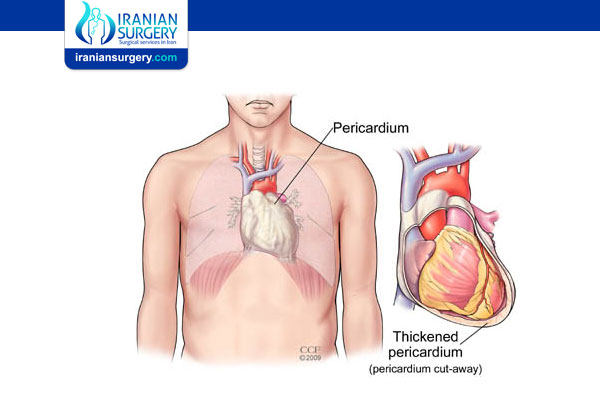Pericardiectomy
What is Pericardiectomy?
Pericardiectomy is the surgical removal of a portion or all of the pericardium. It is also called pericardial stripping. The pericardium is a double-walled, membrane sac that surrounds the heart. It contains a small amount of fluid that lubricates the heart during its normal pumping movements within the pericardium.
About Iranian Surgery
Iranian surgery is an online medical tourism platform where you can find the best Cardiac Surgeons in Iran. The price of Pericardiectomy in Iran can vary according to each individual’s case and will be determined based on an in-person assessment with the doctor.
For more information about the cost of Pericardiectomy in Iran and to schedule an appointment in advance, you can contact Iranian Surgery consultants via WhatsApp number +98 901 929 0946. This service is completely free.
Before Pericardiectomy
What is the function of the pericardium?
The pericardium protects the heart from infection and other sources of disease and holds the heart in the chest wall. The pericardium contains about 50 cc of fluid that lubricates the heart during its normal pumping movements and prevents friction between the heart and the pericardium lining. The pericardium prevents the heart from over-expanding and keeps it functioning normally when blood volume increases due to conditions such as kidney failure, pregnancy or other causes.
Why would a patient require a pericardiectomy?
The most common reason for performing a pericardiectomy is constrictive pericarditis, a condition in which the pericardium has become stiff and calcified. The stiff pericardium prevents the heart from stretching as it normally does when it beats. This causes the heart chambers to fill incompletely with blood, and blood backs up behind the heart. The heart swells, and symptoms of heart failure develop.
Pericardiectomy also can be used to treat recurrent pericarditis, in patients with intractable recurrent symptoms and complications of the anti-inflammatory medications including steroids.
What causes constrictive pericarditis?
There are a number of causes for constrictive pericarditis. At one time, most cases of constrictive pericarditis were idiopathic, meaning the underlying cause was not known. In the past 20 years, this has shifted, and previous heart surgery and radiation to the chest are now leading causes of constrictive pericarditis.
Some other causes include:
. Diseases such as tuberculosis and mesothelioma
. Viral or bacterial infection
. Surgical complications
Can the heart function normally without a pericardium?
The pericardium is not essential for normal heart function. In patients with pericarditis, the pericardium already has lost its lubricating ability so removing it does not make that situation worse. Removing the pericardium does not cause problems as long as the patient’s lungs and diaphragm (the large, dome-shaped muscle below the lungs involved in breathing) are intact.
What options besides surgery are available for treating constrictive pericarditis?
Patients with less severe pericardium constriction may be treated with anti-inflammatory medications. When constriction of the pericardium comes on relatively quickly (within 3-6 months), a syndrome called transient constriction, it may be due in part to inflammation of the pericardium, and this condition may resolve with medications.
For the most advanced cases, surgical treatment is the best option and the one that we recommend.
What are the risks associated with pericardiectomy?
Pericardiectomy is a major cardiac surgery procedure. To minimize risks it should be performed only by a cardiothoracic surgeon experienced in the procedure. The risks of the procedure include the need for cardiopulmonary bypass during surgery, bleeding complications, the need for blood transfusion and death. Older patients, women and patients with other medical problems are at greater risk for complications.
During Pericardiectomy
How is a pericardiectomy performed?
Pericardiectomy is performed through a median sternotomy, an incision through the breastbone (sternum) in the middle front part of the ribs that allows the surgeon to reach the heart. The surgeon will remove the pericardium from the heart, wire the breastbone and ribs back together and close the incision with stitches. Other surgeons may use a thoracotomy approach.
A pericardiectomy cannot safely be done minimally invasively.
After Pericardiectomy
How long do patients stay in the hospital after pericardiectomy?
Most patients stay in the hospital for five to seven days.
How long is the recovery after pericardiectomy?
Patients are permitted to return to their normal activities when they get home, except for lifting. Full recovery after pericardiectomy requires six to eight weeks, depending on how serious the patient’s condition was before the surgery. For the sickest patients before surgery, recovery can take longer than eight weeks.
When do patients feel improvement after surgery?
Patients with severe pericardial constriction who do not have other heart or lung disease often feel improvement immediately after surgery. Most patients notice significant improvement by six to eight weeks and gradually continue improving for a time after the initial recovery period.
What is the long-term outlook after pericardiectomy?
The long-term outlook after pericardiectomy depends on the cause of the constrictive pericarditis. A study published in 2004 that tracked 163 patients over 24 years found that the highest long-term survival was in patients with idiopathic constrictive pericarditis, followed by previous surgery causes and radiation therapy. Tuberculosis and heart attack had survival rates comparable with idiopathic causes. In general, younger patients have higher survival rates than older patients, and healthier patients have better survival rates than patients with other medical conditions.
Is it safe for a patient who has had pericardiectomy to undergo other heart surgeries at a later time?
Scar tissue will form around the heart after pericardiectomy and may form between the heart and surrounding structures such as the lungs and diaphragm. This makes further heart surgeries somewhat challenging but not impossible for experienced cardiac surgeons.
Source:
. https://my.clevelandclinic.org/health/treatments/17352-pericardiectomy

